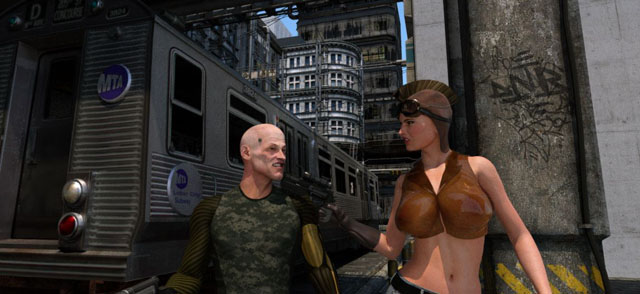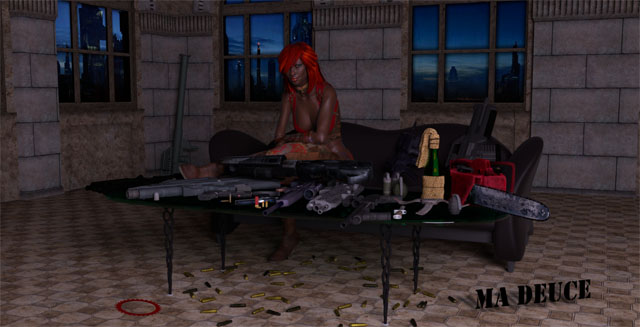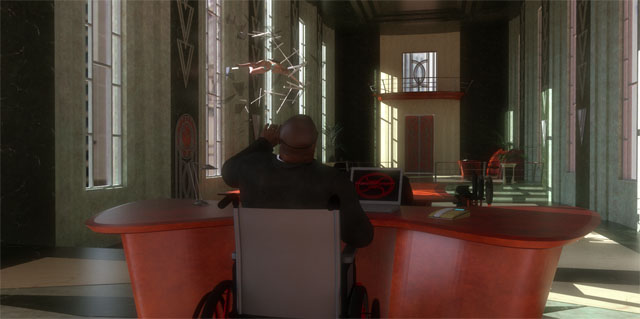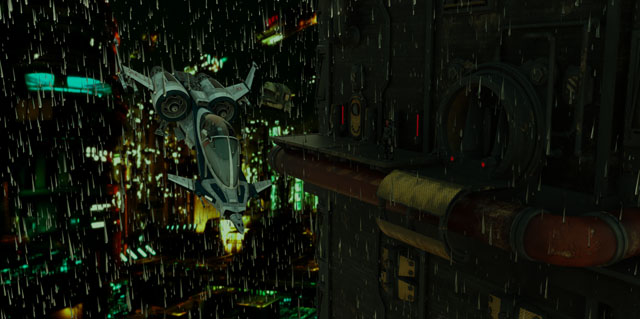 So I know this guy from my time hanging around deviantART. How this meeting came about, I don’t remember, but over the couple of years I have known him I’ve admired a good number of his beautiful renders. LuxRender is his weapon of choice, backed up with DAZ Studio
So I know this guy from my time hanging around deviantART. How this meeting came about, I don’t remember, but over the couple of years I have known him I’ve admired a good number of his beautiful renders. LuxRender is his weapon of choice, backed up with DAZ Studio and Reality 2 point something.
This guy had a kid (well his wife did anyway) and all was quiet for a time. Suddenly he turns back up months later ranting about this crazy idea about making an episodic animation with LuxRender. Any sane guy like me (yes, like me) would be dubious about such outlandish claims, but with a little digging about and a look at what Jean E Dugas (about time to introduce our Texan protagonist by name) has been up to, you start to get the feeling that this might just work. He has a clear and reasoned understanding of where he is and where he needs to get to, and the awesome amount of work required. Just watching the trailer for his project shows a sharp progression of skill and technique.
So, what’s Jean cooking? Well, maybe this is another element that piqued my curiosity; for some years Jean has been working on a series of nanopunk novels under the title, MechaNation. In recent times the denizens of MN have been dying for the animated life, and thus here we are about to talk to Mr Dugas himself.
MechaNation – what is it?
(Polite greetings of gentlemen)
Jim: For those that are new to MechaNation, in short, what’s it all about?
Jean E. Dugas: MechaNation isn’t your typical novel series. Sure, it has roughly the same components as your regular fayre, but it’s put together in such a way that it’s like a cinematic experience for your mind.
The reader first comes into the story arc in 2047, initially in fictitious Lobar City. At this time in human evolution, mechanical augmentation has been superseded by Nanotechnology, pioneered and refined during the final years of the War of 2018. The six main characters are introduced through a dossier-format as a specialized unit of Lazarus Nanotech, the world’s top biotech firm. Their prime directive is to track and retrieve stolen Lazarus biotechnology that has found its way to the Nano Black Market.
There’s a bit of story-building in the first 40 or so pages, but it’s building towards a terrifically dynamic event that will turn the whole world on its ear. It’s difficult to tell much more without major spoilers, but I’ll give everyone a little hint: Mix one part visionary-but-possible technology with one part ultimately evil villain, blend into a tech-hungry and highly populated society, and the result might look something like the zombie of the future. It’s but one little piece of an epic story arc now entering its fourth title.
J: What was it that led to the decision to incorporate graphics into your writing?
JD: Ironically, I was approached by a digital artist early in 2012 who had seen some of my one-off cyber/nanopunk renders and pitched a collaboration to produce a graphic novel series. After I produced the concept art and the back stories for some test characters, the other artist and I went back and forth for several weeks on various ideas. During the work-up time, I read up on some of his projects, and frankly, his material shocked me to a point that, for moral reasons, I needed to sever ties immediately.
After working up all of those ideas which included some great character renders, I felt that the material had merit for at least one novel. I’d never come across visual representations of the characters in a novel, and it seemed like something fun, so why waste the effort!
J: What about the monumental leap into an animated series? Has reader feedback been part of the decision?
JD: Actually, it was kind of a snow-balling idea that originated as an evolution of the MechaNation book trailer for YouTube. I found that I really enjoyed the creative process involved in transferring an idea that only exists in 2D and making it real with 3D animation. The first scene where the camera flies around the destroyed city floored me! I was wearing a grin for weeks as I saw it come to life.
I also learned quite a bit about CG animation over the four months of production time. Like many authors, to see your characters leap off the page and move in 3D space is something we all dream about. I usually work up a list of live-action actors and actresses that would fit various character roles for fun while writing my novels.
Since I don’t have access to the equipment or a massive bankroll, CGI is very accessible for a low-budget production. Sets, cameras, weather, lighting… It’s all easily controlled. And as opposed to live-action, it doesn’t hurt that actor disputes can be settled with a handy Delete key if they want to put up a fight.
J: Where do the animated episodes fit into the story?
JD: Initially, I was going to backtrack to just before the first MechaNation novel started, now that I have the freedom to create new material and a fairly unlimited space to do that with. The project is still in its infancy, and as it also has the fundraising-side of things which offers those who help back the project at various levels the option to have a character either named after them or modeled to their likeness with their input on the details, I’m outlining that variable into the events of the first novel. In the long run, the series will be a more fleshed-out version of the novels with new scenes and interactions spliced to suit. It’s a fantastic setting to play with and I’m eager to get the first sequence banged out.
LuxRender and animation in MechaNation
J: The production of quality CGI animation is always an ambitious project, but when you throw LuxRender into the mix it becomes a whole other magnitude of ambitious. Did you consider applications other than DAZ Studio, Reality 2 and LuxRender? What was it about these programs, and particularly Lux that stuck?
JD: An excellent question with a convoluted answer! For me, the toolset was something I’d invested not only monetary funds into learning, but quite a bit of time. Daz Studio wasn’t actually the first program I picked up, but the incredibly complicated Blender, and then Vue Esprit several years back. I ran my very first test animation in Vue over 27 hours and netted mere seconds of 1080P ‘footage’. It was a long pan-in shot over a desert scene for my Rose Petals and Gunpowder series that I first tried my hand at animating. After I did the math, I found that the render time alone would be over ten years at the quality level I wanted to achieve on my then current hardware, so I put the project on the backburner. After the Vue fiasco, I picked up educational-versions of the Adobe suite and Sculptris, finding the software easier to dive into, but still something that was going to take a considerable learning curve to master.
One day while aimlessly browsing the net, I came across deviantArt and some pretty incredible stills that had been rendered in Studio. I picked up DS3A for a reasonable sum (back when you had to Pay for it!) and started exploring the base gen 3 and 4 characters. Even without the dubious manual, it was easy to learn, create stills, and I had several banged out in just a few hours of messing around with some basic content.
I racked up a good bit of content and converted my RPGP project into a rendered graphic novel idea. I made two videos for YouTube (I think they’re still up) that are a sort of graphic novel with voice-overs, moody music and sound effects. It filled the need for a while, but I never got the animating bug out of my system. Two months later (around November of 2010), I ran across Reality 1.2 in the Daz store, and a whole new world of quality rendering through LuxRender opened my eyes to that high-end look I’d been searching for.
Thousands of still renders and a few years later, I felt I was ready to take another crack at something big!
J: What is it about Lux that puts it ahead of 3Delight, at least as far as your personal decision?
JD: Beside the facts of biased versus unbiased and physically-based materials, the way Lux renders such a beautifully realistic image as (relatively) quickly as it does is about as close to real photography as I can get in a digital environment. Yes, 3Delight can render an image to film-quality (portions of the film ‘District 9’ utilized a higher-end version of 3Delight) but for the average user, it will take double or even triple the render time that it would take Lux to achieve a similar–if not better–image quality. I was skeptical about this when Paolo noted something similar, so of course I put it to the test. And damn the luck, he was right! What Lux can do in a fraction of that time with the same scene is unprecedented. The way Lux and 3Delight read and render light is a literal difference between night and day.
J: Do you rely solely on CPU methods or do you incorporate hybrid or pure GPU rendering?
JD: I’m glad that you mentioned GPU, as I really love the technology and its capability. Rendering with GPU is like having all the CPU cores of ILM at your disposal, but unfortunately, scene size is limited to what will fit on the video card’s RAM. This precarious shortfall wasn’t something I learned until after the fact. Regarding Lux specifically, SmallLux’s GPU function is great when it works, but as the developers have noted, it’s still very much in the experimental stage, and in my use, extremely finicky.
In testing prior to biting into the large-scale MN project, I ran a few animations of the Sandman character in pure GPU mode. Even on my old GTS450’s (which were run in SLI but unfortunately the added RAM made no difference towards scene capacity) I ran 122 frames to 350 passes each in just 8 hours! The problem was that I had to limit the texture sizes to just 2K to fit it onto the primary card, which resulted in his eyes disappearing. That, and the GPU-version of Lux’s shaders don’t look nearly as good as just pure CPU Lux.
Short answer: I run the vast majority of images in straight CPU mode, mainly because most of my scenes are quite massive and easily eclipse the measly 1024MB of RAM available. I know there’s a few cards out there with more RAM, but the largest I’ve come across is 6GB and will set you back a paltry 5 grand USD (Note my sarcasm of ‘paltry’) [Jim: really? :D]. Hybrid mode is more for testing, as I’ve encountered a lot of instability when it does work, but I’m eagerly looking forward to a version of Hybrid that uses the system’s available RAM coupled to the blazing fast processing power of the GPU card, and all is stable! That still seems like a distant accomplishment with any software currently available.
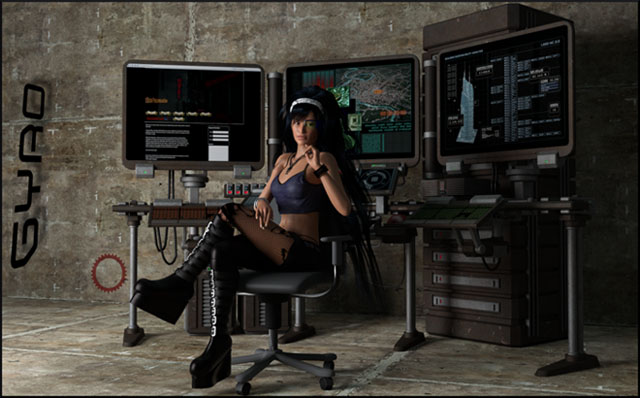 J: Is all of the content to be featured in MechaNation sourced from content brokerages like DAZ 3D? If not, what other sources do you employ – does MN feature any of your own models?
J: Is all of the content to be featured in MechaNation sourced from content brokerages like DAZ 3D? If not, what other sources do you employ – does MN feature any of your own models?
JD: My modeling skills are still very much on the amateur level, but I do a lot of texturing for existing content products to suit my needs. Short answer: about 75% comes from brokerage firms like Daz and Renderosity (and some of the lesser known houses like Vanishing Point, OnTarget3D, etc), but I’m a grateful freebie whore. ShareCG content takes up an awful lot of room on my hard drive!
I’d love to be able to model everything that appears on screen, but for projects like MN, it just isn’t a viable route. I learned early on that studios have hundreds of modelers and texture artists (and thousands of CPU processing cores) for good reason! It takes an incredible amount of time just for one prop or character model to be ‘screen ready’, and again, I’m grateful that there is a community that makes ace content very affordable for people like me.
J: I know that you have released a number of commercial texture sets for existing products. How much of your retexturing skills have made it into MN?
JD: All of the main character skin textures have been through the Gimp machine for MN. […] High-resolution (4k and up) textures are an absolute must when rendering in any appreciably definition, such as what Lux can attain, but conversely, this is what takes up so much room in memory. A lot of editing time is spent on using reference images and touching up seams to make them as seamless as possible, as well as custom bump and Normal map creation to complement every character and any shot that features close-up detail like concrete, weathering on metal and weapons, on an on. I’m an OCD nut when it comes to details, and reworking sets sedates some of that.
To that end, Sandman and Barley’s augmented appendages are also my own, with the geometry based off the Cyberpunk for M4 set on Daz. Perfect Sin for V4 and Tantalus for M4 were both a one-off set with two versions: a normal skin set and the glowing set with appropriate bump and normal maps for those as well. Numerous character clothing items and props get a customization treatment in Gimp to some degree—for nametags, dirt, blood, trans maps, etc; I frequently reskin buildings and signs to suit the setting and kit-bash the hell out of accrued content. There’s also a lot of shader-based magic conjured through the Reality plug-in […]
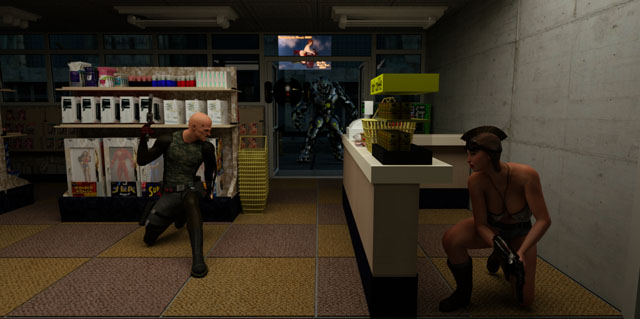 J: What do you make of claims that content use does not result in art?
J: What do you make of claims that content use does not result in art?
JD: In my experience, there’s a lot of negativity circling around ‘ready to render’ content and its relevance to art. To a large degree, there’s a hidden bias by the hordes of traditionalists who view anything pre-prepared as soulless. This particular genre of Digital Art (that being users of RTR content) are grouped into a box as cheats and hacks, and beyond that, ultimately ignored in the grand scale of things.
Personally, it’s a great toolset for those just getting into this new digital medium, or others who don’t possess the skill or have the time/software/what have you/ to do it ‘the old fashioned way’. To my own end, it’s not all that different to what studios employ; I just go about it a little differently, i.e., purchasing prefabricated content and making it work for my needs.[…]
Using ‘RTR’ content is great for everyone involved, and there’s a thriving community to attest to it. Those who create can make a living through this medium that might not be appreciated anywhere else. The content users have the opportunity to go beyond the base models and make something they can truly call their own. Everybody wins, and to hell with the naysayers.
J: I know its early days for the project, but can you give a rough outline of how you approach a scene from creation to rendering, postwork and final animation? Any tips?
JD: Like anything else, it all starts with an idea. Having a script for anything that shows up on camera or any character that moves and/or speaks is a huge part of animating. Stills are so easy by comparison, you just wouldn’t believe unless you’ve tried animating!
After referencing the script/screenplay and detailing the shots and notes for each character, I start with character preparation, make the necessary texture packs or changes (if not done already) for the shot in Gimp, and get the character render-ready in Studio (just the character and accompanying clothing/props, etc at this stage; no background props). The scene is exported to Luxrender via the Reality plug-in. After several test renders and the back-and-forth from Studio to Lux[…] I’ll save the perfected shaders for the character in a Lux shaders file dedicated to the character done through the Reality plug-in, and save the character as its own scene file in Studio for merging.
Following all the characters needed for the shot done as above, I refer to the all-important shot script and start building the scene minus the characters; fleshing out as many props as needed or as I can fit (as I’ve found Studio will freak out and slow to a crawl response-wise if you cram too much geometry or textured props into a scene […] Once I have the set decorated to taste, I’ll plug in one character at a time and start posing or animating—saving Constantly as Studio likes to crash on me at random—and keep plugging away on character motions until everyone is set for their movements. Scrub, scrub, scrub! Set-dependant, I’ll only load the floors and walls, or featured buildings, for this process and load the completed parts until I get all set and ready to export the full sequence.
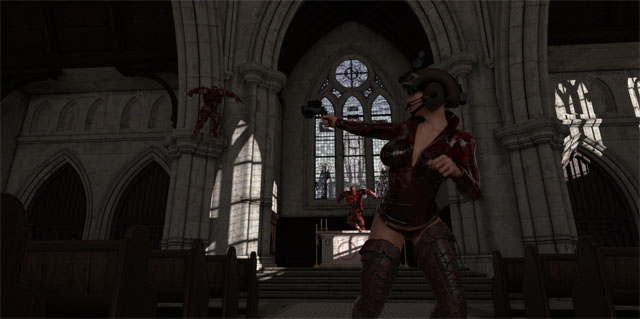 When all of that is wrapped and ready to render, I’ll run the first frame on its own to get a benchmark for how many samples it’s going to take to get a smooth frame in Lux. Exterior scenes clear up super-fast (3-10 minutes for a loaded scene) compared to interior scenes, all settings being relevant. Like anything with Lux, it’s all about Lighting. At the same time, more lights used inefficiently=longer render times. It’s all dependant on that run, so it’s difficult to recommend one particular setting.
When all of that is wrapped and ready to render, I’ll run the first frame on its own to get a benchmark for how many samples it’s going to take to get a smooth frame in Lux. Exterior scenes clear up super-fast (3-10 minutes for a loaded scene) compared to interior scenes, all settings being relevant. Like anything with Lux, it’s all about Lighting. At the same time, more lights used inefficiently=longer render times. It’s all dependant on that run, so it’s difficult to recommend one particular setting.
On postwork, especially with Lux, there’s several schools of thought, but it comes down to how much postwork you want to do, and IF you can keep it consistent frame to frame. For me, it’s far easier to do as much in-camera as possible, so having scenes with smoke and fire emitters, or fog, or extravagant lighting need to be exceptionally well planned and prepared for. Personally, I like postwork to be as minimal as possible when animating, but there are certain things you can’t plan for […]
One shot I did with Sandman in the trailer’s running sequence where he lunges through a broken window, it took 3 full 24 hour days to render 80-odd frames. It was indoors, took way longer than it should have as I didn’t have enough fill lights, and to boot, his kukri knives passed through the window pane and the building.
To correct this monumental flaw, I added glass-break brush effects in Gimp to 29 frames, one painstaking movement at a time, and used both the clone brush and detailed (down to the pixel!) clip, copy, paste, enlarge, and repaint work to make it appear as though his kukri broke a huge chunk out of the window and hundreds of shards followed a gravitational path into the air with him. You see the glass break and fall at full speed, but most of the fine detail from frame to frame is lost as it’s moving at 30 frames per second. Still, no one knew that was post work except me. End note: quality takes time and planning—and if you goof—skill to fix it. […]
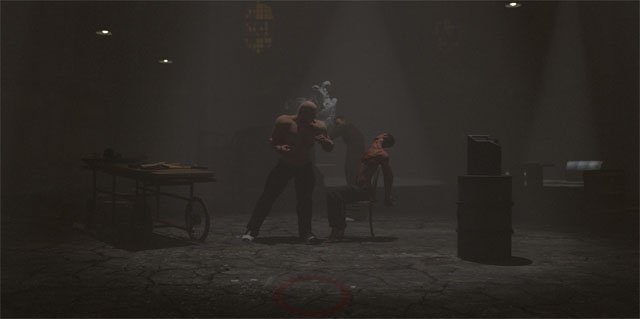 Making MechaNation happen
Making MechaNation happen
J: How can fellow 3D enthusiasts, sci-fi, and techno variety punks help make MN a reality?
JD: There are several ways, actually! Toward getting the render slaves built, I have a project-supporter page on my website with details to how anyone can become a part of this project! Head to crimsonworx.com and look for the Project MN tab on the navigation buttons, handily marked with a big, red **NEW!!** label. There you will find the outline of the project and several packages with accumulating rewards that include your choice of ebooks, a project-exclusive supporter T-shirt, a character named after you, or for the granddaddy of them all, I will put your face onto a character with your name and the details of your character to your liking who will appear in an episode!
The easiest way, as well as the cheapest, is to buy a book! The crimsonworx.com website has them readily linked to the Amazon page. Might as well get a taste of what to expect, eh? [Jim: I hear that]
Also, if anyone happens to be a modeler with some time to kill, I would gratefully appreciate props and vehicle models that I can’t find or create to fill a void. You will receive full credit and an endorsement on the titles, and the model is yours to do with as you wish.
And as always, spreading the word is free! I set up a Facebook page, which gets updated as things role along. Linking the crimsonworx page on your blog, or even telling a friend is a huge help.
J: If I recall correctly there is a fourth novel in the works. What can you tell us about that, and when might we expect to see it?
JD: You are correct! MechaNation: Kingdom Come is currently in the works. If you haven’t read the preceding three, you are missing out on a delicious treat. ;-P Onwards, it has been three years and counting since The Fall. The remaining cast is on the warpath for vengeance in 2051, seeking one of their own, taken against his will by a group grappling for control of the fallen world. This group, known as the WFA, (spoilers if I explained the acronym) occupies the territory west of the Continental Divide and is making bold moves to seize the rest.
The Chop Shop crew arrives in Tokyo 5, a sprawling city apparently cloned from its namesake, but vastly different in origin. The new world and the old coexist amongst its technology-ridden streets, up for grabs by the WFA and an underground presence. Hidden in this surviving city of amazing wonders, the Chop Shop will unleash hell to reclaim what has been lost, but will they come in time to save it?
MechaNation: Kingdom Come is expected to launch in Quarter 4 of 2013.
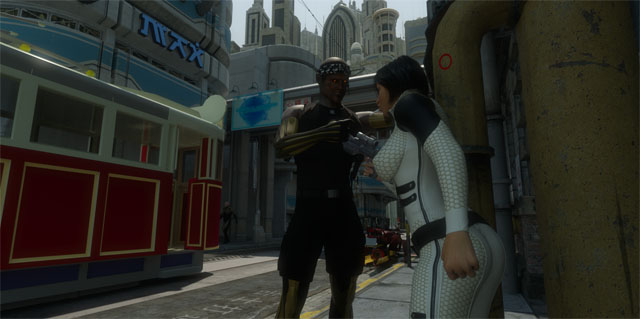 J: Is there anything you would like to add that we haven’t covered?
J: Is there anything you would like to add that we haven’t covered?
JD: Outside of actual rendering and hardware considerations, I still have a few holes in the voice talent roster. I’ve got a local pool that I might be able to coerce from the University’s drama department down the road, but I’d be thrilled if readers or enthusiasts want to get involved. Quality USB mics are cheap I’ve pitched the soundtrack duties to two composers and have one firmly onboard whenever the need arises. The second is on for support and is more on a licensing of his existing library basis.
And the last little bit: each episode is going to be released for free, for as long as I can get away with it!
To close this beast, I give you my sincerest gratitude for allowing me to share a piece of this project with your readers, and I hope you’ve all found something new to sink your teeth into. Sprinkled amongst the rambling, there’s a special project on the rise. Here’s to a great today, a better tomorrow, and a grand future!
Due to the epic nature of this interview it has been edited down in size considerably. For those interested to read there is a full unabridged and unedited version available as a PDF.

